Nursing: A Historical, Contemporary, and Prospective Analysis
VerifiedAdded on 2023/06/03
|10
|2484
|126
Essay
AI Summary
This essay provides a comprehensive overview of the evolution of nursing, tracing its roots back to the Industrial Revolution and the emergence of public health movements. It examines how nursing practices have adapted to address global challenges such as disease transmission, inequitable health resource distribution, and poverty. The essay highlights the importance of leadership models and population-centered care in contemporary nursing, emphasizing the need for nurses to engage with patients, families, and communities. Looking ahead, the essay recommends embracing multicultural workforces and multidisciplinary approaches to improve public health nursing, especially for marginalized communities. It emphasizes the need to balance historical principles with innovative nursing practices to achieve optimal outcomes and improve global health. The paper includes the discussion on the past, present and future recommendations in the field of nursing.
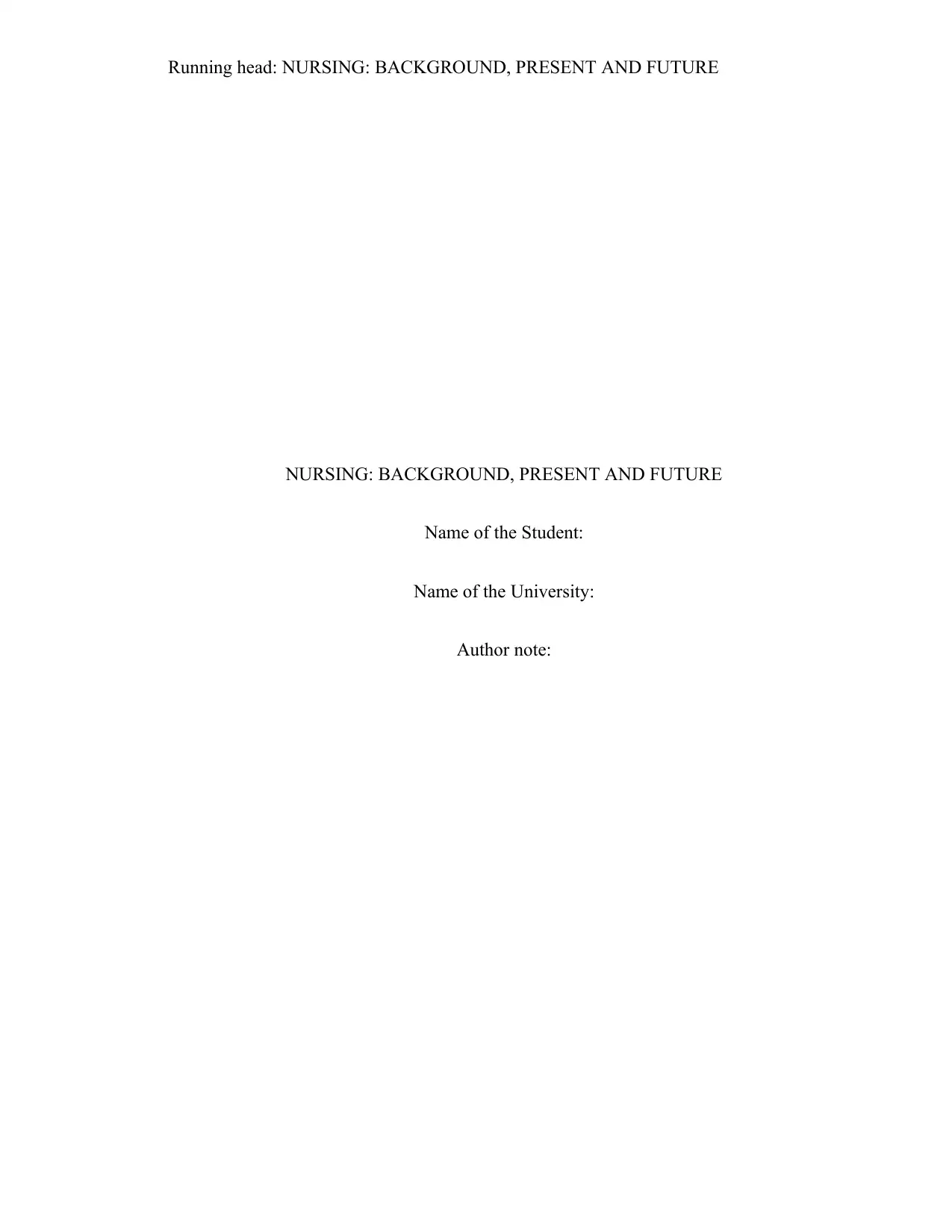
Running head: NURSING: BACKGROUND, PRESENT AND FUTURE
NURSING: BACKGROUND, PRESENT AND FUTURE
Name of the Student:
Name of the University:
Author note:
NURSING: BACKGROUND, PRESENT AND FUTURE
Name of the Student:
Name of the University:
Author note:
Paraphrase This Document
Need a fresh take? Get an instant paraphrase of this document with our AI Paraphraser
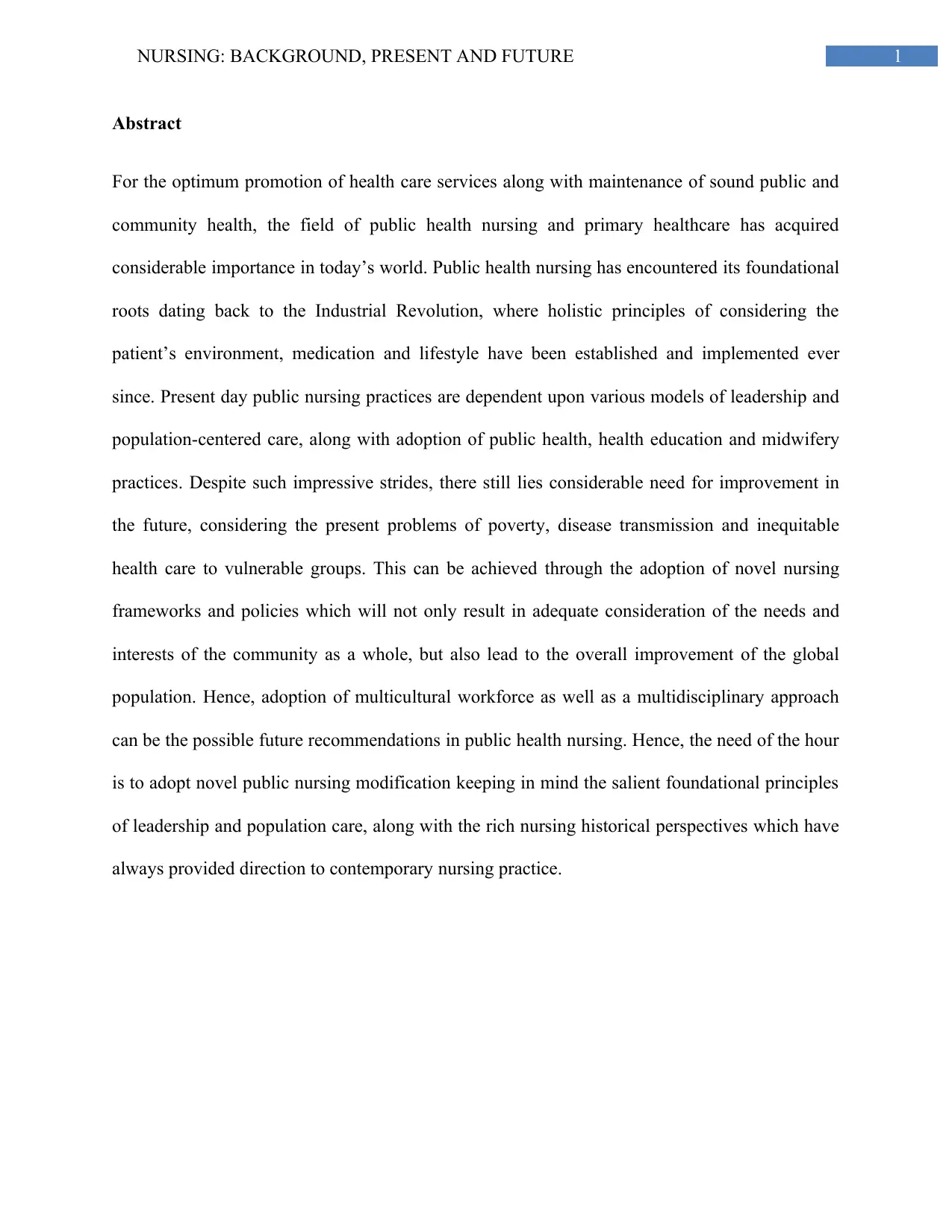
1NURSING: BACKGROUND, PRESENT AND FUTURE
Abstract
For the optimum promotion of health care services along with maintenance of sound public and
community health, the field of public health nursing and primary healthcare has acquired
considerable importance in today’s world. Public health nursing has encountered its foundational
roots dating back to the Industrial Revolution, where holistic principles of considering the
patient’s environment, medication and lifestyle have been established and implemented ever
since. Present day public nursing practices are dependent upon various models of leadership and
population-centered care, along with adoption of public health, health education and midwifery
practices. Despite such impressive strides, there still lies considerable need for improvement in
the future, considering the present problems of poverty, disease transmission and inequitable
health care to vulnerable groups. This can be achieved through the adoption of novel nursing
frameworks and policies which will not only result in adequate consideration of the needs and
interests of the community as a whole, but also lead to the overall improvement of the global
population. Hence, adoption of multicultural workforce as well as a multidisciplinary approach
can be the possible future recommendations in public health nursing. Hence, the need of the hour
is to adopt novel public nursing modification keeping in mind the salient foundational principles
of leadership and population care, along with the rich nursing historical perspectives which have
always provided direction to contemporary nursing practice.
Abstract
For the optimum promotion of health care services along with maintenance of sound public and
community health, the field of public health nursing and primary healthcare has acquired
considerable importance in today’s world. Public health nursing has encountered its foundational
roots dating back to the Industrial Revolution, where holistic principles of considering the
patient’s environment, medication and lifestyle have been established and implemented ever
since. Present day public nursing practices are dependent upon various models of leadership and
population-centered care, along with adoption of public health, health education and midwifery
practices. Despite such impressive strides, there still lies considerable need for improvement in
the future, considering the present problems of poverty, disease transmission and inequitable
health care to vulnerable groups. This can be achieved through the adoption of novel nursing
frameworks and policies which will not only result in adequate consideration of the needs and
interests of the community as a whole, but also lead to the overall improvement of the global
population. Hence, adoption of multicultural workforce as well as a multidisciplinary approach
can be the possible future recommendations in public health nursing. Hence, the need of the hour
is to adopt novel public nursing modification keeping in mind the salient foundational principles
of leadership and population care, along with the rich nursing historical perspectives which have
always provided direction to contemporary nursing practice.

2NURSING: BACKGROUND, PRESENT AND FUTURE
Table of Contents
Introduction..........................................................................................................................3
Discussion............................................................................................................................3
Background: Dynamic Nursing Practices........................................................................3
Past: Public Health Movement........................................................................................4
Present: Models and Practices.........................................................................................5
Future Recommendations................................................................................................7
Conclusion...........................................................................................................................7
References............................................................................................................................8
Table of Contents
Introduction..........................................................................................................................3
Discussion............................................................................................................................3
Background: Dynamic Nursing Practices........................................................................3
Past: Public Health Movement........................................................................................4
Present: Models and Practices.........................................................................................5
Future Recommendations................................................................................................7
Conclusion...........................................................................................................................7
References............................................................................................................................8
⊘ This is a preview!⊘
Do you want full access?
Subscribe today to unlock all pages.

Trusted by 1+ million students worldwide
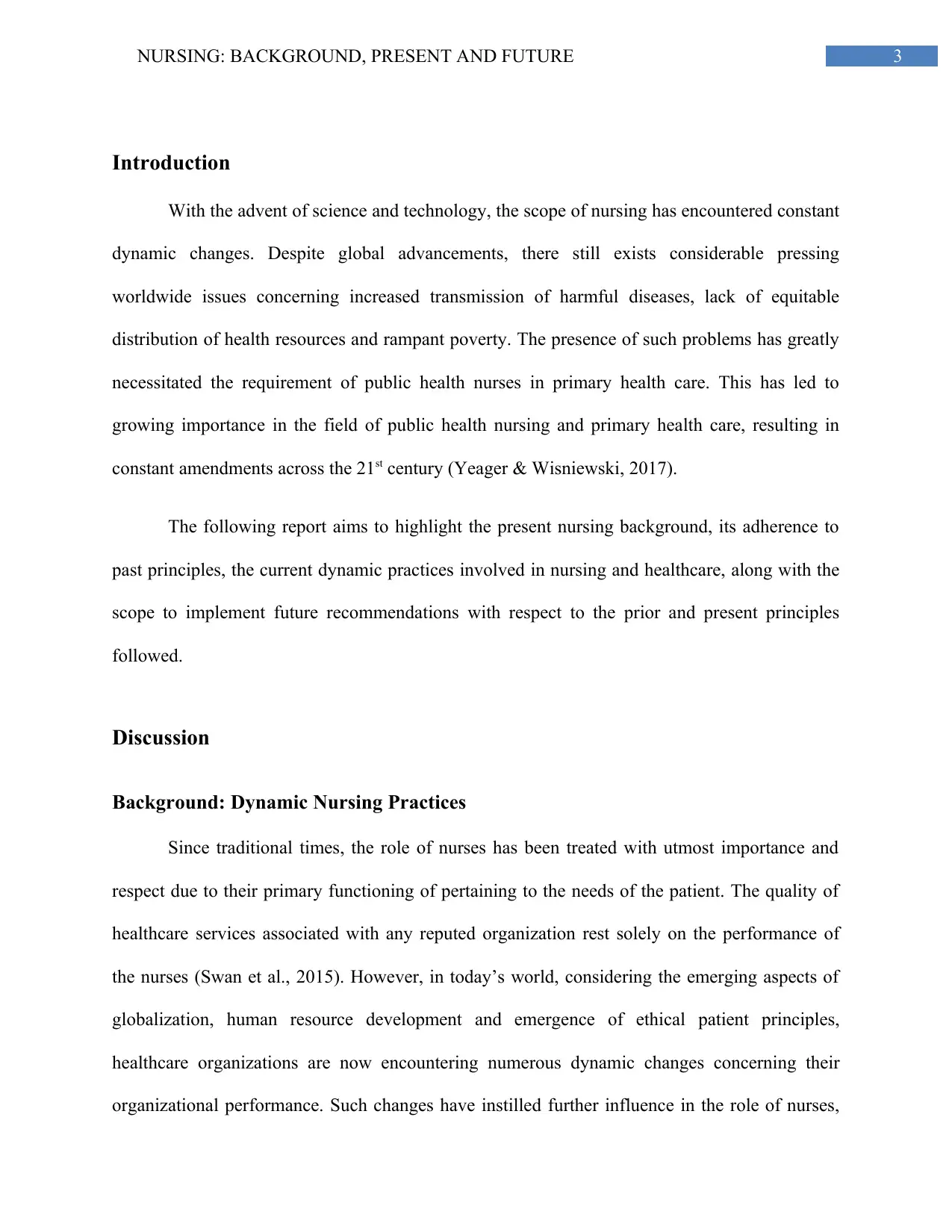
3NURSING: BACKGROUND, PRESENT AND FUTURE
Introduction
With the advent of science and technology, the scope of nursing has encountered constant
dynamic changes. Despite global advancements, there still exists considerable pressing
worldwide issues concerning increased transmission of harmful diseases, lack of equitable
distribution of health resources and rampant poverty. The presence of such problems has greatly
necessitated the requirement of public health nurses in primary health care. This has led to
growing importance in the field of public health nursing and primary health care, resulting in
constant amendments across the 21st century (Yeager & Wisniewski, 2017).
The following report aims to highlight the present nursing background, its adherence to
past principles, the current dynamic practices involved in nursing and healthcare, along with the
scope to implement future recommendations with respect to the prior and present principles
followed.
Discussion
Background: Dynamic Nursing Practices
Since traditional times, the role of nurses has been treated with utmost importance and
respect due to their primary functioning of pertaining to the needs of the patient. The quality of
healthcare services associated with any reputed organization rest solely on the performance of
the nurses (Swan et al., 2015). However, in today’s world, considering the emerging aspects of
globalization, human resource development and emergence of ethical patient principles,
healthcare organizations are now encountering numerous dynamic changes concerning their
organizational performance. Such changes have instilled further influence in the role of nurses,
Introduction
With the advent of science and technology, the scope of nursing has encountered constant
dynamic changes. Despite global advancements, there still exists considerable pressing
worldwide issues concerning increased transmission of harmful diseases, lack of equitable
distribution of health resources and rampant poverty. The presence of such problems has greatly
necessitated the requirement of public health nurses in primary health care. This has led to
growing importance in the field of public health nursing and primary health care, resulting in
constant amendments across the 21st century (Yeager & Wisniewski, 2017).
The following report aims to highlight the present nursing background, its adherence to
past principles, the current dynamic practices involved in nursing and healthcare, along with the
scope to implement future recommendations with respect to the prior and present principles
followed.
Discussion
Background: Dynamic Nursing Practices
Since traditional times, the role of nurses has been treated with utmost importance and
respect due to their primary functioning of pertaining to the needs of the patient. The quality of
healthcare services associated with any reputed organization rest solely on the performance of
the nurses (Swan et al., 2015). However, in today’s world, considering the emerging aspects of
globalization, human resource development and emergence of ethical patient principles,
healthcare organizations are now encountering numerous dynamic changes concerning their
organizational performance. Such changes have instilled further influence in the role of nurses,
Paraphrase This Document
Need a fresh take? Get an instant paraphrase of this document with our AI Paraphraser
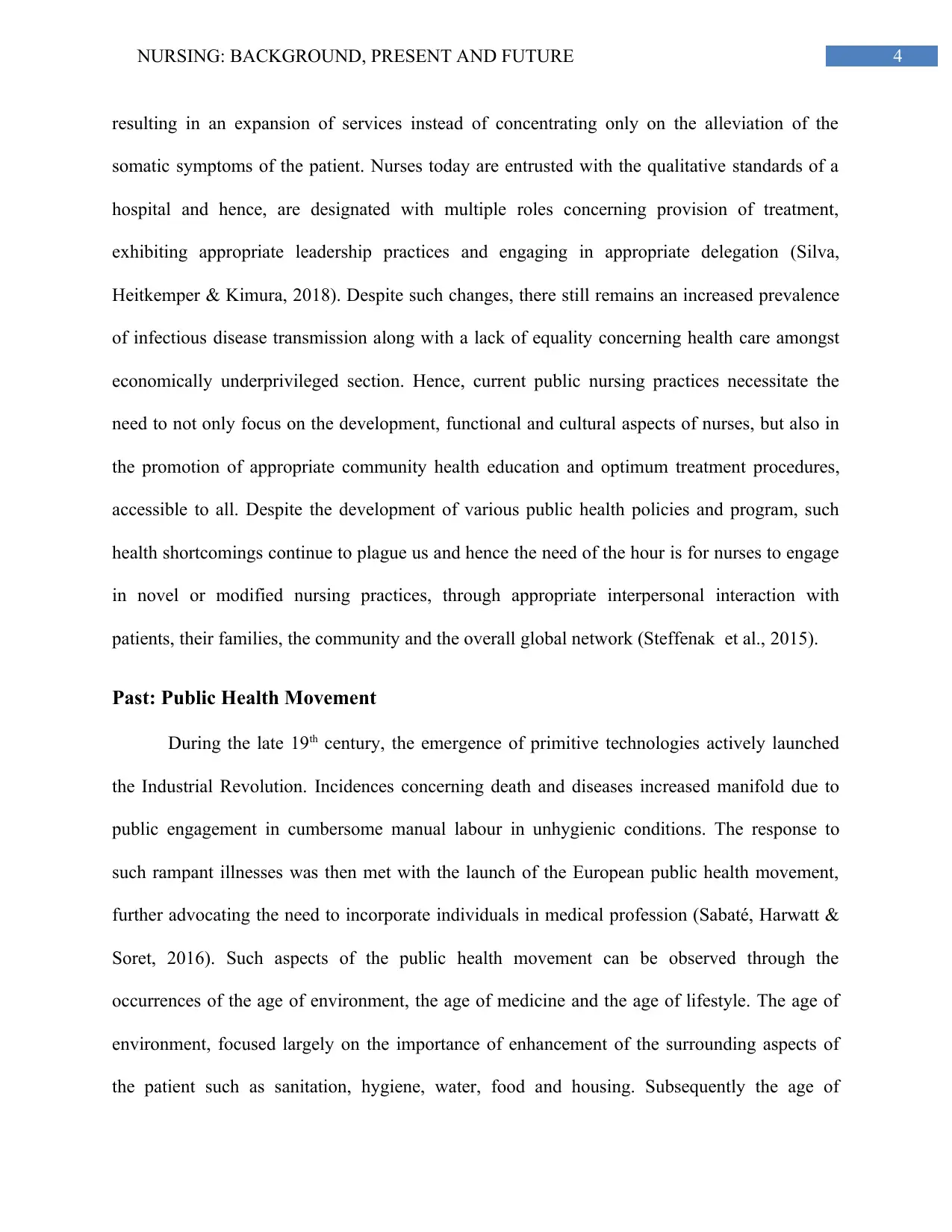
4NURSING: BACKGROUND, PRESENT AND FUTURE
resulting in an expansion of services instead of concentrating only on the alleviation of the
somatic symptoms of the patient. Nurses today are entrusted with the qualitative standards of a
hospital and hence, are designated with multiple roles concerning provision of treatment,
exhibiting appropriate leadership practices and engaging in appropriate delegation (Silva,
Heitkemper & Kimura, 2018). Despite such changes, there still remains an increased prevalence
of infectious disease transmission along with a lack of equality concerning health care amongst
economically underprivileged section. Hence, current public nursing practices necessitate the
need to not only focus on the development, functional and cultural aspects of nurses, but also in
the promotion of appropriate community health education and optimum treatment procedures,
accessible to all. Despite the development of various public health policies and program, such
health shortcomings continue to plague us and hence the need of the hour is for nurses to engage
in novel or modified nursing practices, through appropriate interpersonal interaction with
patients, their families, the community and the overall global network (Steffenak et al., 2015).
Past: Public Health Movement
During the late 19th century, the emergence of primitive technologies actively launched
the Industrial Revolution. Incidences concerning death and diseases increased manifold due to
public engagement in cumbersome manual labour in unhygienic conditions. The response to
such rampant illnesses was then met with the launch of the European public health movement,
further advocating the need to incorporate individuals in medical profession (Sabaté, Harwatt &
Soret, 2016). Such aspects of the public health movement can be observed through the
occurrences of the age of environment, the age of medicine and the age of lifestyle. The age of
environment, focused largely on the importance of enhancement of the surrounding aspects of
the patient such as sanitation, hygiene, water, food and housing. Subsequently the age of
resulting in an expansion of services instead of concentrating only on the alleviation of the
somatic symptoms of the patient. Nurses today are entrusted with the qualitative standards of a
hospital and hence, are designated with multiple roles concerning provision of treatment,
exhibiting appropriate leadership practices and engaging in appropriate delegation (Silva,
Heitkemper & Kimura, 2018). Despite such changes, there still remains an increased prevalence
of infectious disease transmission along with a lack of equality concerning health care amongst
economically underprivileged section. Hence, current public nursing practices necessitate the
need to not only focus on the development, functional and cultural aspects of nurses, but also in
the promotion of appropriate community health education and optimum treatment procedures,
accessible to all. Despite the development of various public health policies and program, such
health shortcomings continue to plague us and hence the need of the hour is for nurses to engage
in novel or modified nursing practices, through appropriate interpersonal interaction with
patients, their families, the community and the overall global network (Steffenak et al., 2015).
Past: Public Health Movement
During the late 19th century, the emergence of primitive technologies actively launched
the Industrial Revolution. Incidences concerning death and diseases increased manifold due to
public engagement in cumbersome manual labour in unhygienic conditions. The response to
such rampant illnesses was then met with the launch of the European public health movement,
further advocating the need to incorporate individuals in medical profession (Sabaté, Harwatt &
Soret, 2016). Such aspects of the public health movement can be observed through the
occurrences of the age of environment, the age of medicine and the age of lifestyle. The age of
environment, focused largely on the importance of enhancement of the surrounding aspects of
the patient such as sanitation, hygiene, water, food and housing. Subsequently the age of
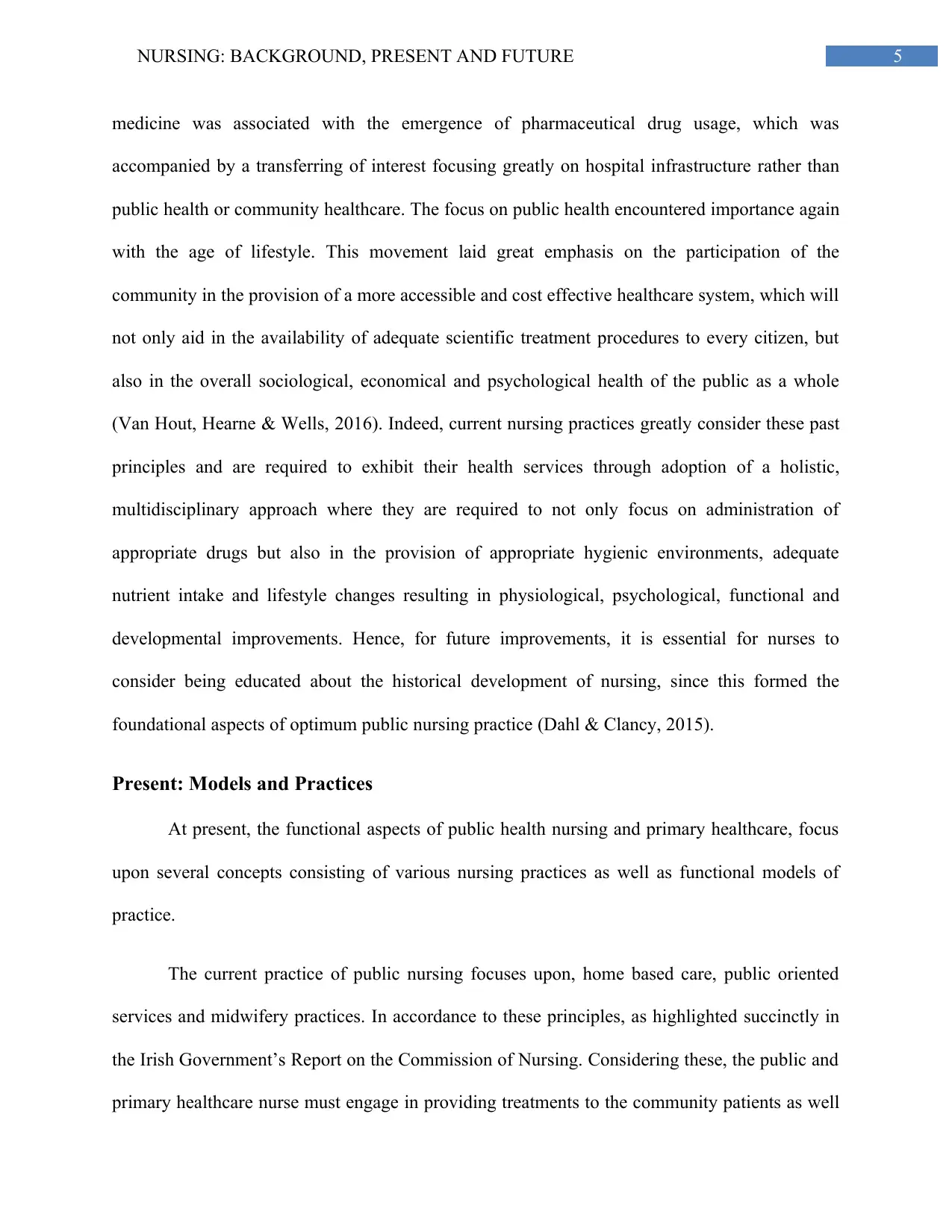
5NURSING: BACKGROUND, PRESENT AND FUTURE
medicine was associated with the emergence of pharmaceutical drug usage, which was
accompanied by a transferring of interest focusing greatly on hospital infrastructure rather than
public health or community healthcare. The focus on public health encountered importance again
with the age of lifestyle. This movement laid great emphasis on the participation of the
community in the provision of a more accessible and cost effective healthcare system, which will
not only aid in the availability of adequate scientific treatment procedures to every citizen, but
also in the overall sociological, economical and psychological health of the public as a whole
(Van Hout, Hearne & Wells, 2016). Indeed, current nursing practices greatly consider these past
principles and are required to exhibit their health services through adoption of a holistic,
multidisciplinary approach where they are required to not only focus on administration of
appropriate drugs but also in the provision of appropriate hygienic environments, adequate
nutrient intake and lifestyle changes resulting in physiological, psychological, functional and
developmental improvements. Hence, for future improvements, it is essential for nurses to
consider being educated about the historical development of nursing, since this formed the
foundational aspects of optimum public nursing practice (Dahl & Clancy, 2015).
Present: Models and Practices
At present, the functional aspects of public health nursing and primary healthcare, focus
upon several concepts consisting of various nursing practices as well as functional models of
practice.
The current practice of public nursing focuses upon, home based care, public oriented
services and midwifery practices. In accordance to these principles, as highlighted succinctly in
the Irish Government’s Report on the Commission of Nursing. Considering these, the public and
primary healthcare nurse must engage in providing treatments to the community patients as well
medicine was associated with the emergence of pharmaceutical drug usage, which was
accompanied by a transferring of interest focusing greatly on hospital infrastructure rather than
public health or community healthcare. The focus on public health encountered importance again
with the age of lifestyle. This movement laid great emphasis on the participation of the
community in the provision of a more accessible and cost effective healthcare system, which will
not only aid in the availability of adequate scientific treatment procedures to every citizen, but
also in the overall sociological, economical and psychological health of the public as a whole
(Van Hout, Hearne & Wells, 2016). Indeed, current nursing practices greatly consider these past
principles and are required to exhibit their health services through adoption of a holistic,
multidisciplinary approach where they are required to not only focus on administration of
appropriate drugs but also in the provision of appropriate hygienic environments, adequate
nutrient intake and lifestyle changes resulting in physiological, psychological, functional and
developmental improvements. Hence, for future improvements, it is essential for nurses to
consider being educated about the historical development of nursing, since this formed the
foundational aspects of optimum public nursing practice (Dahl & Clancy, 2015).
Present: Models and Practices
At present, the functional aspects of public health nursing and primary healthcare, focus
upon several concepts consisting of various nursing practices as well as functional models of
practice.
The current practice of public nursing focuses upon, home based care, public oriented
services and midwifery practices. In accordance to these principles, as highlighted succinctly in
the Irish Government’s Report on the Commission of Nursing. Considering these, the public and
primary healthcare nurse must engage in providing treatments to the community patients as well
⊘ This is a preview!⊘
Do you want full access?
Subscribe today to unlock all pages.

Trusted by 1+ million students worldwide
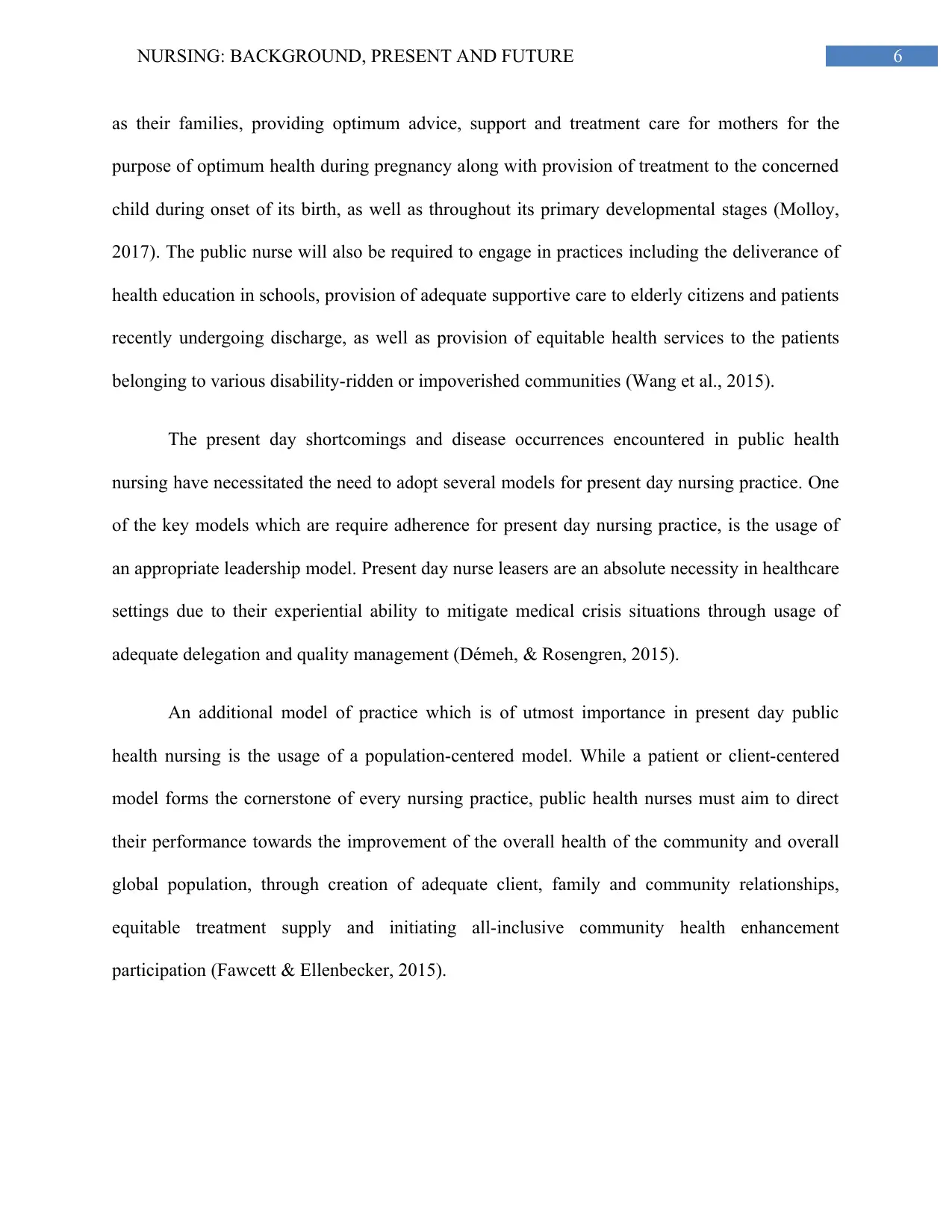
6NURSING: BACKGROUND, PRESENT AND FUTURE
as their families, providing optimum advice, support and treatment care for mothers for the
purpose of optimum health during pregnancy along with provision of treatment to the concerned
child during onset of its birth, as well as throughout its primary developmental stages (Molloy,
2017). The public nurse will also be required to engage in practices including the deliverance of
health education in schools, provision of adequate supportive care to elderly citizens and patients
recently undergoing discharge, as well as provision of equitable health services to the patients
belonging to various disability-ridden or impoverished communities (Wang et al., 2015).
The present day shortcomings and disease occurrences encountered in public health
nursing have necessitated the need to adopt several models for present day nursing practice. One
of the key models which are require adherence for present day nursing practice, is the usage of
an appropriate leadership model. Present day nurse leasers are an absolute necessity in healthcare
settings due to their experiential ability to mitigate medical crisis situations through usage of
adequate delegation and quality management (Démeh, & Rosengren, 2015).
An additional model of practice which is of utmost importance in present day public
health nursing is the usage of a population-centered model. While a patient or client-centered
model forms the cornerstone of every nursing practice, public health nurses must aim to direct
their performance towards the improvement of the overall health of the community and overall
global population, through creation of adequate client, family and community relationships,
equitable treatment supply and initiating all-inclusive community health enhancement
participation (Fawcett & Ellenbecker, 2015).
as their families, providing optimum advice, support and treatment care for mothers for the
purpose of optimum health during pregnancy along with provision of treatment to the concerned
child during onset of its birth, as well as throughout its primary developmental stages (Molloy,
2017). The public nurse will also be required to engage in practices including the deliverance of
health education in schools, provision of adequate supportive care to elderly citizens and patients
recently undergoing discharge, as well as provision of equitable health services to the patients
belonging to various disability-ridden or impoverished communities (Wang et al., 2015).
The present day shortcomings and disease occurrences encountered in public health
nursing have necessitated the need to adopt several models for present day nursing practice. One
of the key models which are require adherence for present day nursing practice, is the usage of
an appropriate leadership model. Present day nurse leasers are an absolute necessity in healthcare
settings due to their experiential ability to mitigate medical crisis situations through usage of
adequate delegation and quality management (Démeh, & Rosengren, 2015).
An additional model of practice which is of utmost importance in present day public
health nursing is the usage of a population-centered model. While a patient or client-centered
model forms the cornerstone of every nursing practice, public health nurses must aim to direct
their performance towards the improvement of the overall health of the community and overall
global population, through creation of adequate client, family and community relationships,
equitable treatment supply and initiating all-inclusive community health enhancement
participation (Fawcett & Ellenbecker, 2015).
Paraphrase This Document
Need a fresh take? Get an instant paraphrase of this document with our AI Paraphraser
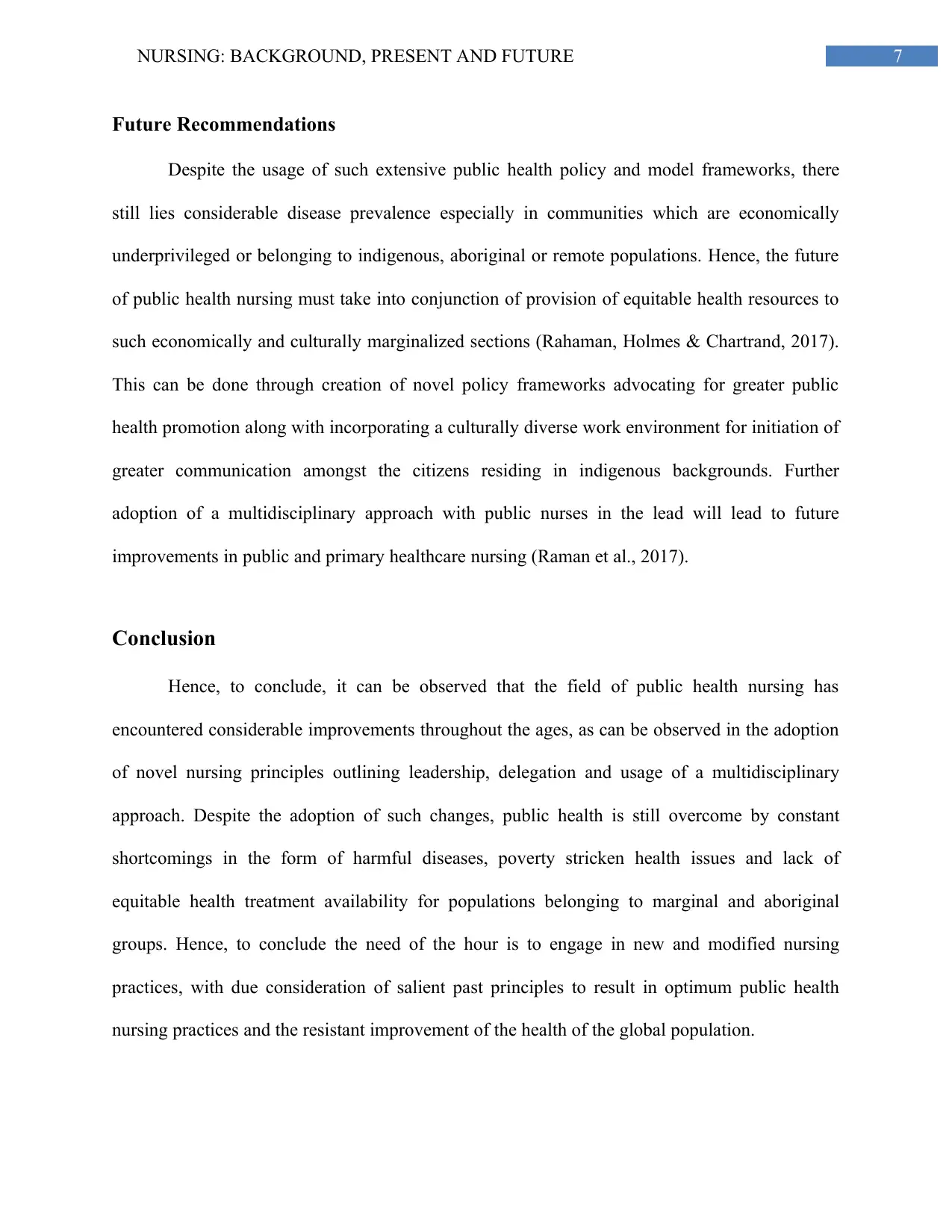
7NURSING: BACKGROUND, PRESENT AND FUTURE
Future Recommendations
Despite the usage of such extensive public health policy and model frameworks, there
still lies considerable disease prevalence especially in communities which are economically
underprivileged or belonging to indigenous, aboriginal or remote populations. Hence, the future
of public health nursing must take into conjunction of provision of equitable health resources to
such economically and culturally marginalized sections (Rahaman, Holmes & Chartrand, 2017).
This can be done through creation of novel policy frameworks advocating for greater public
health promotion along with incorporating a culturally diverse work environment for initiation of
greater communication amongst the citizens residing in indigenous backgrounds. Further
adoption of a multidisciplinary approach with public nurses in the lead will lead to future
improvements in public and primary healthcare nursing (Raman et al., 2017).
Conclusion
Hence, to conclude, it can be observed that the field of public health nursing has
encountered considerable improvements throughout the ages, as can be observed in the adoption
of novel nursing principles outlining leadership, delegation and usage of a multidisciplinary
approach. Despite the adoption of such changes, public health is still overcome by constant
shortcomings in the form of harmful diseases, poverty stricken health issues and lack of
equitable health treatment availability for populations belonging to marginal and aboriginal
groups. Hence, to conclude the need of the hour is to engage in new and modified nursing
practices, with due consideration of salient past principles to result in optimum public health
nursing practices and the resistant improvement of the health of the global population.
Future Recommendations
Despite the usage of such extensive public health policy and model frameworks, there
still lies considerable disease prevalence especially in communities which are economically
underprivileged or belonging to indigenous, aboriginal or remote populations. Hence, the future
of public health nursing must take into conjunction of provision of equitable health resources to
such economically and culturally marginalized sections (Rahaman, Holmes & Chartrand, 2017).
This can be done through creation of novel policy frameworks advocating for greater public
health promotion along with incorporating a culturally diverse work environment for initiation of
greater communication amongst the citizens residing in indigenous backgrounds. Further
adoption of a multidisciplinary approach with public nurses in the lead will lead to future
improvements in public and primary healthcare nursing (Raman et al., 2017).
Conclusion
Hence, to conclude, it can be observed that the field of public health nursing has
encountered considerable improvements throughout the ages, as can be observed in the adoption
of novel nursing principles outlining leadership, delegation and usage of a multidisciplinary
approach. Despite the adoption of such changes, public health is still overcome by constant
shortcomings in the form of harmful diseases, poverty stricken health issues and lack of
equitable health treatment availability for populations belonging to marginal and aboriginal
groups. Hence, to conclude the need of the hour is to engage in new and modified nursing
practices, with due consideration of salient past principles to result in optimum public health
nursing practices and the resistant improvement of the health of the global population.

8NURSING: BACKGROUND, PRESENT AND FUTURE
References
Dahl, B. M., & Clancy, A. (2015). Meanings of knowledge and identity in public health nursing
in a time of transition: interpretations of public health nurses’ narratives. Scandinavian
journal of caring sciences, 29(4), 679-687.
Démeh, W., & Rosengren, K. (2015). The visualisation of clinical leadership in the content of
nursing education—a qualitative study of nursing students' experiences. Nurse education
today, 35(7), 888-893.
Fawcett, J., & Ellenbecker, C. H. (2015). A proposed conceptual model of nursing and
population health. Nursing outlook, 63(3), 288-298.
Molloy, L. (2017). Nursing care and indigenous Australians: An
autoethnography. Collegian, 24(5), 487-490.
Rahaman, Z., Holmes, D., & Chartrand, L. (2017). An opportunity for healing and holistic care:
Exploring the roles of health care providers working within Northern Canadian
Aboriginal communities. Journal of Holistic Nursing, 35(2), 185-197.
Raman, S., Ruston, S., Irwin, S., Tran, P., Hotton, P., & Thorne, S. (2017). Taking culture
seriously: Can we improve the developmental health and well‐being of Australian
Aboriginal children in out‐of‐home care?. Child: care, health and development, 43(6),
899-905.
Sabaté, J., Harwatt, H., & Soret, S. (2016). Environmental nutrition: A new frontier for public
health. American journal of public health, 106(5), 815-821.
References
Dahl, B. M., & Clancy, A. (2015). Meanings of knowledge and identity in public health nursing
in a time of transition: interpretations of public health nurses’ narratives. Scandinavian
journal of caring sciences, 29(4), 679-687.
Démeh, W., & Rosengren, K. (2015). The visualisation of clinical leadership in the content of
nursing education—a qualitative study of nursing students' experiences. Nurse education
today, 35(7), 888-893.
Fawcett, J., & Ellenbecker, C. H. (2015). A proposed conceptual model of nursing and
population health. Nursing outlook, 63(3), 288-298.
Molloy, L. (2017). Nursing care and indigenous Australians: An
autoethnography. Collegian, 24(5), 487-490.
Rahaman, Z., Holmes, D., & Chartrand, L. (2017). An opportunity for healing and holistic care:
Exploring the roles of health care providers working within Northern Canadian
Aboriginal communities. Journal of Holistic Nursing, 35(2), 185-197.
Raman, S., Ruston, S., Irwin, S., Tran, P., Hotton, P., & Thorne, S. (2017). Taking culture
seriously: Can we improve the developmental health and well‐being of Australian
Aboriginal children in out‐of‐home care?. Child: care, health and development, 43(6),
899-905.
Sabaté, J., Harwatt, H., & Soret, S. (2016). Environmental nutrition: A new frontier for public
health. American journal of public health, 106(5), 815-821.
⊘ This is a preview!⊘
Do you want full access?
Subscribe today to unlock all pages.

Trusted by 1+ million students worldwide
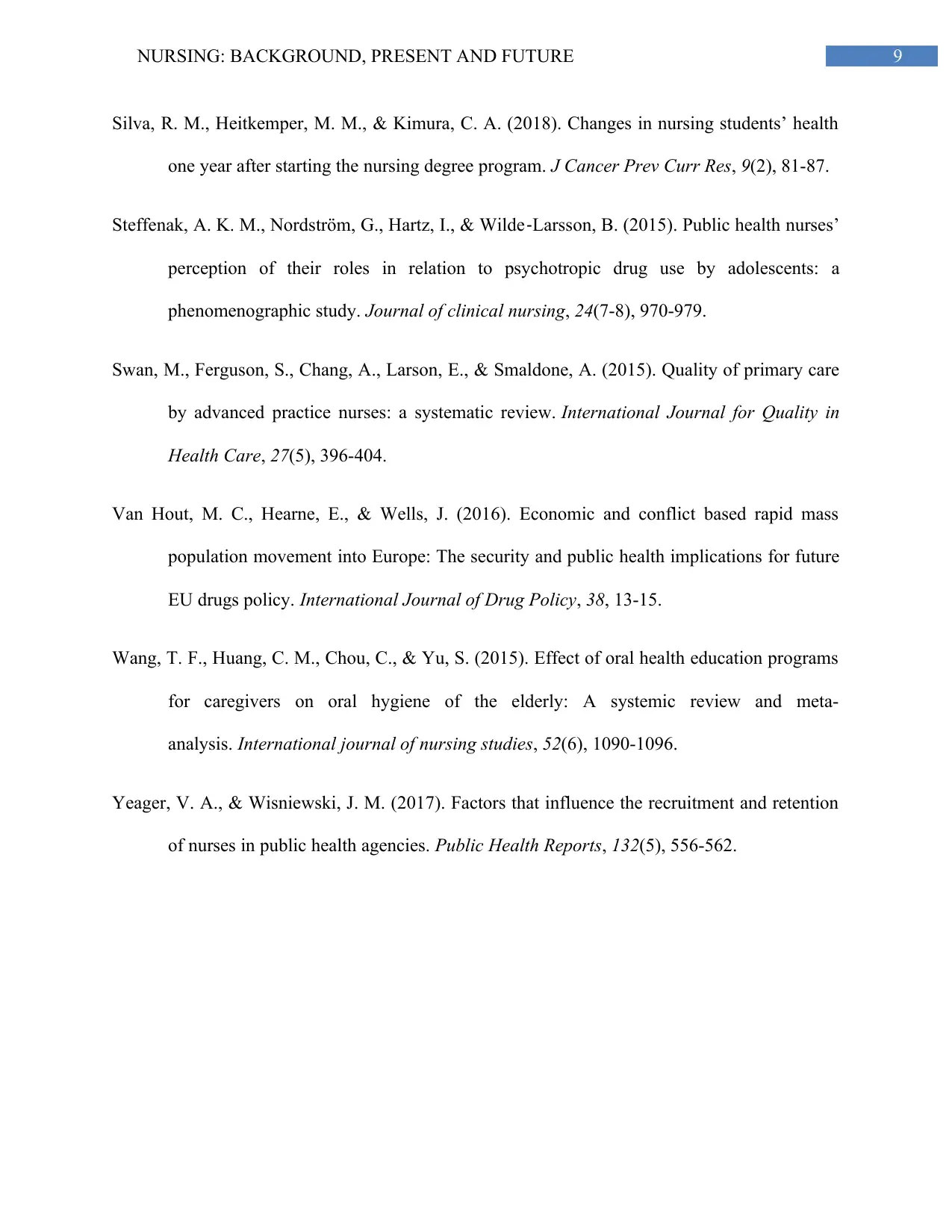
9NURSING: BACKGROUND, PRESENT AND FUTURE
Silva, R. M., Heitkemper, M. M., & Kimura, C. A. (2018). Changes in nursing students’ health
one year after starting the nursing degree program. J Cancer Prev Curr Res, 9(2), 81-87.
Steffenak, A. K. M., Nordström, G., Hartz, I., & Wilde‐Larsson, B. (2015). Public health nurses’
perception of their roles in relation to psychotropic drug use by adolescents: a
phenomenographic study. Journal of clinical nursing, 24(7-8), 970-979.
Swan, M., Ferguson, S., Chang, A., Larson, E., & Smaldone, A. (2015). Quality of primary care
by advanced practice nurses: a systematic review. International Journal for Quality in
Health Care, 27(5), 396-404.
Van Hout, M. C., Hearne, E., & Wells, J. (2016). Economic and conflict based rapid mass
population movement into Europe: The security and public health implications for future
EU drugs policy. International Journal of Drug Policy, 38, 13-15.
Wang, T. F., Huang, C. M., Chou, C., & Yu, S. (2015). Effect of oral health education programs
for caregivers on oral hygiene of the elderly: A systemic review and meta-
analysis. International journal of nursing studies, 52(6), 1090-1096.
Yeager, V. A., & Wisniewski, J. M. (2017). Factors that influence the recruitment and retention
of nurses in public health agencies. Public Health Reports, 132(5), 556-562.
Silva, R. M., Heitkemper, M. M., & Kimura, C. A. (2018). Changes in nursing students’ health
one year after starting the nursing degree program. J Cancer Prev Curr Res, 9(2), 81-87.
Steffenak, A. K. M., Nordström, G., Hartz, I., & Wilde‐Larsson, B. (2015). Public health nurses’
perception of their roles in relation to psychotropic drug use by adolescents: a
phenomenographic study. Journal of clinical nursing, 24(7-8), 970-979.
Swan, M., Ferguson, S., Chang, A., Larson, E., & Smaldone, A. (2015). Quality of primary care
by advanced practice nurses: a systematic review. International Journal for Quality in
Health Care, 27(5), 396-404.
Van Hout, M. C., Hearne, E., & Wells, J. (2016). Economic and conflict based rapid mass
population movement into Europe: The security and public health implications for future
EU drugs policy. International Journal of Drug Policy, 38, 13-15.
Wang, T. F., Huang, C. M., Chou, C., & Yu, S. (2015). Effect of oral health education programs
for caregivers on oral hygiene of the elderly: A systemic review and meta-
analysis. International journal of nursing studies, 52(6), 1090-1096.
Yeager, V. A., & Wisniewski, J. M. (2017). Factors that influence the recruitment and retention
of nurses in public health agencies. Public Health Reports, 132(5), 556-562.
1 out of 10
Related Documents
Your All-in-One AI-Powered Toolkit for Academic Success.
+13062052269
info@desklib.com
Available 24*7 on WhatsApp / Email
![[object Object]](/_next/static/media/star-bottom.7253800d.svg)
Unlock your academic potential
Copyright © 2020–2025 A2Z Services. All Rights Reserved. Developed and managed by ZUCOL.




